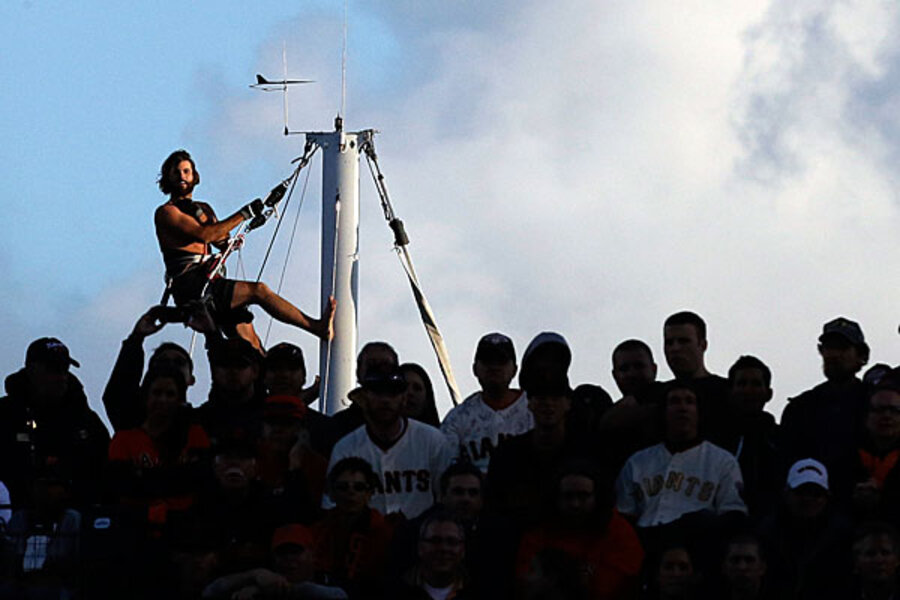How to watch the 2012 World Series in San Francisco for free
Loading...
| San Francisco
They're teens skipping school and adults driving through the night to line up before dawn in soggy San Francisco - all for a chance to watch a few innings of the World Series for free.
The die-hard fans are known as the "knothole gang," a group prepared to endure all sorts of discomfort for their Giants, just as they did at AT&T Park in 2010 when the team battled the Texas Rangers, and again in September and through the playoffs.
Early Wednesday, the fans began lining up again, and the queue kept on growing as game time approached.
From the park's "knothole," the lucky ones share the same vantage point as Giants right fielder Hunter Pence, peering through a chain-link fence enclosing four viewing portals stretching about 100 feet under the right-field stands. They'll shake the fence and scream insults at the opposing right fielder, who stands just a few feet from them.
RECOMMENDED: Are you a real San Francisco Giants fan? Take the quiz
There is no other place like it in the Major Leagues. The Giants' ballpark is the only stadium in the country with the feature, but there are rules: No chairs, dogs or drinking. And every three innings, stadium security rotates people in and out. Security guards allow about 75 fans into the area for each shift.
But for those who lined up 12 hours or more before the first pitch, the price was right.
"I could afford maybe one ticket, but not a ticket for everyone," said Tony Bryson, 44, who traveled from Sacramento with his two sons and three of their friends to secure a guaranteed spot in the viewing area. They arrived around 7 a.m. and bundled up against the cold and rain of the early morning.
Bryson and his group also viewed the 2010 World Series from the "knothole" area and they and the other regulars wouldn't have it any other way.
"The energy of the crowd is fantastic," said Alex Busch, 27, of Reedley, Calif. who said he spends the other six innings outside the viewing area with hundreds of other fans gathered on the walkway between the right-field-wall and McCovey Cove, which attracts kayaks and boaters awaiting "splash hits."
Some brave sailors even attempted to view the National League Championship Series against the St. Louis Cardinals from atop their boat's masts, the tallest of which peak over the right-field wall.
For most, though, lining up outside the "knothole" viewing area for a chance to watch three innings of free baseball is work enough.
"Thank God they included this when they erected this house that Barry Bonds built," said James Calhoun, 47, of Suisin City, who arrived at about 5:30 a.m. "Otherwise, I couldn't afford to watch this in person."
During the regular season, the competition for a viewing spot isn't as fierce and fans can watch entire regular season games for free. But the lines grow longer and tempers get shorter the closer the San Francisco Giants get to the post season.
Calhoun and the other regulars abide by a few hard and fast rules, the biggest of which is no saving a spot for others. Regulars like Calhoun police the line and keep track of who showed up when.
"Only those who wait are rewarded," Calhoun said.
The line continued to grow outside the part throughout Wednesday morning as the public address announcer practiced reading the San Francisco Giants lineup and the grounds crew scurried about the field with mowers, rakes and wheel barrows.
Calhoun said once his three-inning shift ends, he will join the rowdy crowd gathered on the Promenade who count on those inside the viewing area to shout out big plays while still catching snippets of the action by looking over the shoulders of those inside.
"This is much better than going to school," said Nick Bryson, 13, of Sacramento. "I feel sorry for my friends who are in school right now."
RECOMMENDED: Are you a real San Francisco Giants fan? Take the quiz
Copyright 2012 The Associated Press.







